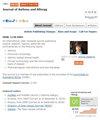Frequency of Severe Asthma and Its Clinical Phenotypes at the Asthma Clinic in One of the Largest Sudanese Tertiary Pediatric Hospitals: A Cross-Sectional Hospital-Outpatient-Based Study
IF 3.7
3区 医学
Q2 ALLERGY
引用次数: 0
Abstract
Background: Asthma is one of the most common non-communicable diseases. Childhood asthma has been increasing in Sudan, with a 13– 16% prevalence among Khartoum school children. To achieve and maintain good asthma control, proper diagnosis, assessment of severity, and appropriate medication administration are crucial, with phenotyping being a key factor in determining patients’ specific treatment.Objective: To study the frequency of severe asthma and the distribution of its different phenotypes and to investigate associations between age and gender and different phenotypes of asthma.
Methodology: This descriptive cross-sectional hospital-based study was conducted in the Asthma Clinic of Mohamed Al-Amin Hamid Pediatrics Hospital. It included 229 patients who were presented to the clinic from September 2021 to April 2022. Data were collected from the patients and/or their caregivers using a modified validated standard questionnaire and were analyzed using SPSS version 26.0. A p-value of 0.05 or less was considered statistically significant.
Results: In this study of 229 participants, 14.4% had severe asthma, with 44.5% and 41% exhibiting mild and moderate asthma, respectively. Most were effectively managed in steps 2 or 3. The cohort, primarily aged 5 or younger (40.2%) with a male majority (62%), showed a mean diagnosis age of 2.9 ± 2.8 years. Impressively, 90% maintained well-controlled asthma. Within severe asthma cases (87% atopic), 39.4% represented a severe allergic asthma phenotype. Elevated eosinophil counts were noted in 45.5% (serum) and 78.8% (sputum cytology), while 57.6% had normal serum IgE levels. The predominant symptom pattern in severe asthma was episodic multi-trigger wheezing (48.5%). Age and gender displayed no significant association with severe asthma phenotype.
Conclusion: This study reveals a concerning rise in childhood asthma prevalence in Sudan, emphasizing the importance of tailored treatment strategies. Severe asthma, characterized by atopic eosinophilic involvement, necessitates targeted interventions in pediatric asthma care for specific phenotypes.
苏丹最大的儿科三级医院之一的哮喘门诊中严重哮喘的发病率及其临床表型:基于医院门诊病人的横断面研究
背景:哮喘是最常见的非传染性疾病之一:哮喘是最常见的非传染性疾病之一。苏丹儿童哮喘的发病率一直在上升,喀土穆学龄儿童的发病率为 13-16%。要实现并保持对哮喘的良好控制,正确诊断、评估严重程度和适当用药至关重要,而表型分析则是决定患者具体治疗方法的关键因素:研究重症哮喘的发病率及其不同表型的分布情况,并探讨年龄、性别与哮喘不同表型之间的关系:这项描述性横断面医院研究在穆罕默德-阿明-哈米德儿科医院哮喘门诊进行。研究对象包括 2021 年 9 月至 2022 年 4 月期间就诊的 229 名患者。研究人员使用修改过的有效标准问卷向患者和/或其护理人员收集数据,并使用 SPSS 26.0 版进行分析。P值小于或等于0.05为具有统计学意义:在 229 名参与者中,14.4% 患有重度哮喘,44.5% 和 41% 分别为轻度和中度哮喘。大多数人在第二或第三步得到了有效控制。研究对象的年龄主要在 5 岁或以下(40.2%),男性占多数(62%),平均诊断年龄为 2.9±2.8 岁。令人印象深刻的是,90%的哮喘患者都能保持良好的哮喘控制。在重症哮喘病例(87%为特应性)中,39.4%为重度过敏性哮喘表型。45.5%(血清)和78.8%(痰细胞学检查)的患者嗜酸性粒细胞计数升高,而57.6%的患者血清IgE水平正常。重症哮喘的主要症状模式是发作性多诱因喘息(48.5%)。年龄和性别与重症哮喘表型无明显关联:本研究揭示了苏丹儿童哮喘发病率上升的令人担忧的情况,强调了因地制宜的治疗策略的重要性。以特异性嗜酸性粒细胞参与为特征的重症哮喘需要针对特定表型的儿科哮喘护理采取有针对性的干预措施。
本文章由计算机程序翻译,如有差异,请以英文原文为准。
求助全文
约1分钟内获得全文
求助全文
来源期刊

Journal of Asthma and Allergy
Medicine-Immunology and Allergy
CiteScore
5.30
自引率
6.20%
发文量
185
审稿时长
16 weeks
期刊介绍:
An international, peer-reviewed journal publishing original research, reports, editorials and commentaries on the following topics: Asthma; Pulmonary physiology; Asthma related clinical health; Clinical immunology and the immunological basis of disease; Pharmacological interventions and new therapies.
Although the main focus of the journal will be to publish research and clinical results in humans, preclinical, animal and in vitro studies will be published where they shed light on disease processes and potential new therapies.
 求助内容:
求助内容: 应助结果提醒方式:
应助结果提醒方式:


